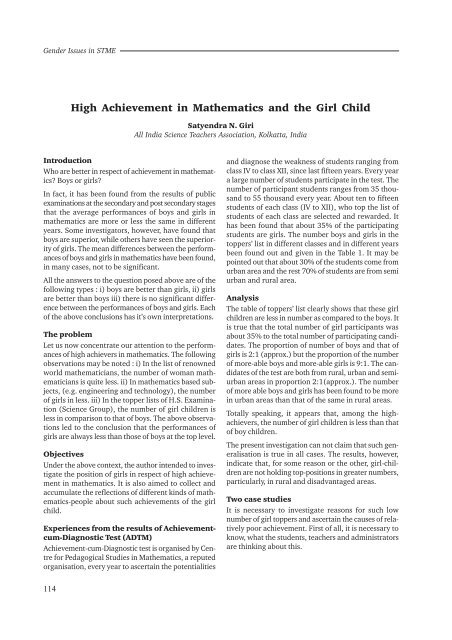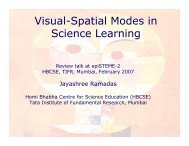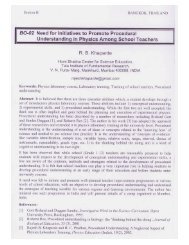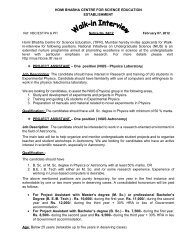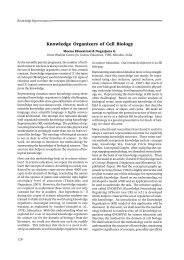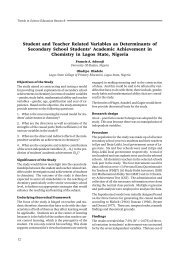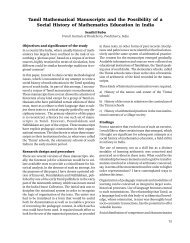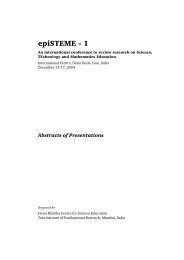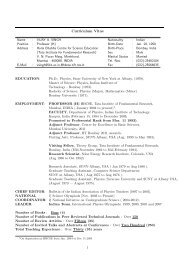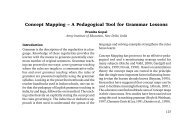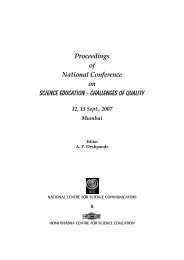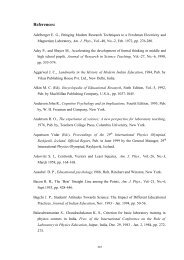High Achievement in Mathematics and the Girl Child - Homi Bhabha ...
High Achievement in Mathematics and the Girl Child - Homi Bhabha ...
High Achievement in Mathematics and the Girl Child - Homi Bhabha ...
You also want an ePaper? Increase the reach of your titles
YUMPU automatically turns print PDFs into web optimized ePapers that Google loves.
Gender Issues <strong>in</strong> STMEThe number of Toppers <strong>in</strong> different classes from IV - XIIYear IV V VI VII VIII IX X XI XII Total Gr<strong>and</strong>Boys <strong>Girl</strong>s Boys <strong>Girl</strong>s Boys <strong>Girl</strong>s Boys <strong>Girl</strong>s Boys <strong>Girl</strong>s Boys <strong>Girl</strong>s Boys <strong>Girl</strong>s Boys <strong>Girl</strong>s Boys <strong>Girl</strong>s Boys <strong>Girl</strong>s Total1996 13 4 12 0 12 4 12 3 17 0 13 0 12 0 3 0 2 0 96 11 1071997 19 5 11 1 9 2 8 1 12 0 12 1 8 4 2 0 2 0 83 14 971998 14 1 11 3 11 1 7 1 10 0 9 0 9 1 3 0 2 1 76 8 831999 12 0 12 1 10 2 11 0 10 1 9 0 9 0 2 0 3 0 78 4 822000 10 1 10 2 11 1 11 1 11 3 11 0 5 1 2 0 2 0 75 9 842001 7 1 7 1 7 1 6 2 8 0 9 1 7 0 3 0 3 0 57 6 632002 12 0 9 3 9 1 8 2 10 2 15 1 9 0 8 0 3 0 83 9 952003 9 4 12 0 11 0 10 0 11 2 9 1 12 0 9 0 7 0 90 7 97Total 96 16 84 11 80 12 73 10 89 8 87 4 71 6 32 0 24 1 63 68 704Table 1: Number of toppers <strong>in</strong> <strong>Achievement</strong>-cum-Diagnostic Test <strong>in</strong> 1996 – 2003.The follow<strong>in</strong>g steps were undertaken.i) An <strong>in</strong>stant talk competition was arranged by <strong>the</strong>author, 12 students of class XI, <strong>and</strong> each one fromtwelve schools of which six were from Boys’ <strong>and</strong> o<strong>the</strong>rsix from girls’ schools of Kolkata. Each student wasasked to talk on <strong>the</strong> topic, “ Why are <strong>the</strong> girls weak <strong>in</strong>ma<strong>the</strong>matics?” The boys <strong>and</strong> girls gave relevant arguments<strong>in</strong> support of <strong>the</strong>ir answers. The responses revealeda lot of ideas <strong>in</strong> regard to so called weakness ofgirls <strong>in</strong> ma<strong>the</strong>matics.ii) A second step was taken. Twenty experts of whomten are males <strong>and</strong> ten are females were selected. Theexperts were teacher-educators, teachers of ma<strong>the</strong>maticsfrom schools <strong>and</strong> colleges, <strong>and</strong> educational adm<strong>in</strong>istrators.All of <strong>the</strong>m were participants of a sem<strong>in</strong>aron ma<strong>the</strong>matics teach<strong>in</strong>g organised by Centre for PedagogicalStudies <strong>in</strong> <strong>Ma<strong>the</strong>matics</strong>. Each of <strong>the</strong> twentyparticipants were asked to state reasons on <strong>the</strong> issue‘Why is <strong>the</strong> number of girls less than that of boys among<strong>the</strong> high achievers <strong>in</strong> ma<strong>the</strong>matics?’ The group of expertstook <strong>the</strong> issue enthusiastically <strong>and</strong> gave <strong>the</strong>ir op<strong>in</strong>ions<strong>and</strong> comments regard<strong>in</strong>g such achievement ofgirls.Why is <strong>the</strong> number less?The op<strong>in</strong>ions expressed <strong>in</strong> <strong>the</strong> talk competition by <strong>the</strong>students, both boys <strong>and</strong> <strong>the</strong> girls were collected. Aga<strong>in</strong><strong>the</strong> op<strong>in</strong>ions <strong>and</strong> comments expressed by <strong>the</strong> expertswere also taken <strong>in</strong>to account. F<strong>in</strong>ally a list was prepared,which accord<strong>in</strong>g to <strong>the</strong> above respondents werereasons for low achievement of girls. These reasonswere many, diverse <strong>and</strong> varied. It is to be noted that<strong>the</strong>se reasons are not exhaustive. They, however, give aglimpse of what learners as well as experts th<strong>in</strong>k aboutsuch low achievement of girls.Reasons for low achievement of <strong>the</strong> girl childAn analysis of <strong>the</strong> op<strong>in</strong>ions of learners of experts revealed<strong>the</strong> follow<strong>in</strong>g:i) Most of <strong>the</strong> male experts op<strong>in</strong>ed that majority of<strong>the</strong> girl children are ‘naturally’ weak <strong>in</strong> ma<strong>the</strong>matics<strong>and</strong> <strong>in</strong> ma<strong>the</strong>matical reason<strong>in</strong>g, while most of <strong>the</strong> femaleexperts did not agree to such a comment.ii) The guardians do not usually encourage <strong>the</strong> studyof ma<strong>the</strong>matics for <strong>the</strong>ir daughters.iii) The guardians normally th<strong>in</strong>k at <strong>the</strong> very beg<strong>in</strong>n<strong>in</strong>gthat <strong>the</strong> girl children are poor <strong>in</strong> ma<strong>the</strong>matics.iv) The girl children have lesser <strong>in</strong>terest, attitude <strong>and</strong>attention <strong>in</strong> ma<strong>the</strong>matical th<strong>in</strong>k<strong>in</strong>g.v) In <strong>the</strong> matrimonial market <strong>the</strong> would-be-husb<strong>and</strong>s<strong>and</strong> <strong>the</strong>ir parents prefer that <strong>the</strong> prospective bride shouldbe conversant <strong>in</strong> f<strong>in</strong>e arts (dance, music, draw<strong>in</strong>g etc.)<strong>and</strong> <strong>the</strong> humanities, ra<strong>the</strong>r than <strong>in</strong> ma<strong>the</strong>matics, science<strong>and</strong> eng<strong>in</strong>eer<strong>in</strong>g.vi) In rural areas, <strong>the</strong> negligence of <strong>the</strong> guardians <strong>and</strong><strong>the</strong> society of <strong>the</strong> girl child <strong>in</strong> <strong>the</strong>ir study of ma<strong>the</strong>matics<strong>and</strong> science is highly discourag<strong>in</strong>g.vii) The girls have to do household work <strong>in</strong> addition to<strong>the</strong>ir study.viii) The girls are prohibited from go<strong>in</strong>g outside <strong>and</strong>discuss<strong>in</strong>g <strong>the</strong> lessons with <strong>the</strong>ir boy friends, <strong>and</strong> maletutors <strong>and</strong> teachers.ix) The experts agreed that <strong>the</strong>re are many bright girlchildren also, who are learn<strong>in</strong>g ma<strong>the</strong>matics with joy<strong>and</strong> enthusiasm <strong>in</strong> a better way than many of <strong>the</strong>ir boyclassmates.x) The expert group also op<strong>in</strong>ed that, given properopportunity <strong>and</strong> encouragement, <strong>the</strong> girl child can excel<strong>in</strong> <strong>the</strong> same way as <strong>the</strong> boys.xi) Accord<strong>in</strong>g to <strong>the</strong>m it is encourag<strong>in</strong>g that <strong>the</strong> girlchildren are do<strong>in</strong>g better now as compared to earlierdays.xii)The number of girl students <strong>in</strong> a particular sampleis less <strong>and</strong> hence <strong>the</strong> number of high achiever girls isless.115
Gender Issues <strong>in</strong> STMExiii) Boys are more efficient <strong>in</strong> ‘hall manage’ than<strong>the</strong> girls <strong>and</strong> hence boys get greater score <strong>in</strong> ma<strong>the</strong>maticsthan girls.Observations <strong>and</strong> <strong>the</strong>ir <strong>in</strong>terpretationsFirst of all, it is to be admitted that <strong>the</strong> observationobta<strong>in</strong>ed from <strong>the</strong> results of ADTM for boys <strong>and</strong> girlsare conf<strong>in</strong>ed only to <strong>the</strong> population taken <strong>in</strong> <strong>the</strong> study.Thus, <strong>the</strong> observation that <strong>the</strong> number of girls is lessthan that of <strong>the</strong> girls <strong>in</strong> respect of high achievement <strong>in</strong>ma<strong>the</strong>matics can not taken as a generalised conclusion.In fact, we often f<strong>in</strong>d many bright girl studentswho are sh<strong>in</strong><strong>in</strong>g <strong>in</strong> future as em<strong>in</strong>ent ma<strong>the</strong>maticians.But many facts, figures <strong>and</strong> f<strong>in</strong>d<strong>in</strong>gs as stated <strong>in</strong> ourpaper earlier, show that <strong>the</strong> number of girl-toppers isless than that of <strong>the</strong> boy-toppers <strong>in</strong> regard to achievement<strong>in</strong> ma<strong>the</strong>matics.Some op<strong>in</strong>ions for this underachievement of girl childhave been given above. It is to be carefully exam<strong>in</strong>edto what extent <strong>the</strong>y can be accepted as valid reasonsfor under achievement of <strong>the</strong> girl child. It has beenseen that ‘bright’ girl students <strong>in</strong> ma<strong>the</strong>matics are less<strong>in</strong> rural areas than <strong>in</strong> urban areas.It can thus be said that as socio-cultural conditionsimprove, <strong>the</strong> consciousness of gender equality also improves,<strong>and</strong> as such, <strong>the</strong> girl child gets greater motivationto do better.Ano<strong>the</strong>r significant f<strong>in</strong>d<strong>in</strong>g is that such bright girl studentsare less <strong>in</strong> upper grades than <strong>in</strong> lower grades.At lower secondary stages <strong>the</strong> boys <strong>and</strong> girls get, tosome extent, equal educational opportunity. But, atupper secondary <strong>and</strong> higher secondary stages, <strong>the</strong> attentionof guardians are focussed more on boys thangirls. Aga<strong>in</strong> <strong>the</strong> parent also takes greater attention tosee that <strong>the</strong>ir daughters take up humanities subjectsra<strong>the</strong>r than science subjects. Thus <strong>the</strong> issue of such underachievement ultimately reduces to social neglect of <strong>the</strong>girl child. In fact, <strong>in</strong> many cases, parents give moreattention to boys, because <strong>the</strong>y th<strong>in</strong>k that boys will getjobs <strong>and</strong> will help <strong>the</strong> family <strong>in</strong> future, so <strong>the</strong>y select<strong>the</strong> boy child for study of science <strong>and</strong> ma<strong>the</strong>matics,<strong>and</strong> provide maximum possible facilities to <strong>the</strong>m. Thewhole atmosphere of learn<strong>in</strong>g ma<strong>the</strong>matics for <strong>the</strong> girlchild is <strong>in</strong> most cases not congenial for ma<strong>the</strong>maticalstudy. Aga<strong>in</strong>, <strong>the</strong> would-be-husb<strong>and</strong>s <strong>and</strong> his familymembers prefer <strong>the</strong> bride to be conversant <strong>in</strong> f<strong>in</strong>e arts,music, dance, cook<strong>in</strong>g, humanities etc. ra<strong>the</strong>r thanbe<strong>in</strong>g engaged <strong>in</strong> <strong>the</strong> study of ma<strong>the</strong>matics.Let us consider <strong>the</strong> simulation <strong>in</strong> <strong>the</strong> classroom also <strong>in</strong>co-education classes, <strong>the</strong> teacher has <strong>in</strong> many cases<strong>the</strong> pre-occupied idea that boys are superior to girls,<strong>and</strong> so asks more questions to boys <strong>and</strong> lesser numberof questions to <strong>the</strong> girls. The girls, on <strong>the</strong> o<strong>the</strong>r h<strong>and</strong>,be<strong>in</strong>g naturally shy <strong>and</strong> timid, do not <strong>in</strong>tend to respondproperly. The spontaneous <strong>in</strong>tention of learn<strong>in</strong>g is thusthwarted. Be<strong>in</strong>g deprived of encouragement from parents,teachers, boy friends, family members <strong>and</strong> <strong>the</strong>society, <strong>the</strong> girl child herself starts th<strong>in</strong>k<strong>in</strong>g that she is<strong>in</strong>ferior to <strong>the</strong> boy child <strong>in</strong> <strong>the</strong> study of higher ma<strong>the</strong>matics.It must, however be admitted that <strong>the</strong> above gloomysituation of learn<strong>in</strong>g ma<strong>the</strong>matics is not always true.But, <strong>in</strong> most cases, <strong>the</strong> under-achievement of <strong>the</strong> girlchild <strong>in</strong> ma<strong>the</strong>matics, <strong>in</strong> case of occupy<strong>in</strong>g top-positions,is due to <strong>the</strong> negative attitude of gender-differenceto <strong>the</strong> girl child by <strong>the</strong> school, family <strong>and</strong> <strong>the</strong>society.116
Gender Issues <strong>in</strong> STMEThe Role of <strong>Ma<strong>the</strong>matics</strong> Education <strong>in</strong>Women EmpowermentEve KadyamarungaZimbabwe School Exam<strong>in</strong>ations Council, Harare, ZimbabweThe importance of <strong>Ma<strong>the</strong>matics</strong> as a tool for science<strong>and</strong> technology is cont<strong>in</strong>ually <strong>in</strong>creas<strong>in</strong>g. While science<strong>and</strong> technology have become so pervasive, ma<strong>the</strong>maticseducation has cont<strong>in</strong>ued to dom<strong>in</strong>ate <strong>the</strong> schoolcurriculum <strong>and</strong> rema<strong>in</strong>s a key subject area requirement<strong>in</strong> higher education <strong>and</strong> employment sector.The hue <strong>and</strong> cry which follow <strong>the</strong> publication of ma<strong>the</strong>maticsresults has become an annual ritual. The postmortemsabout <strong>the</strong> results eclipses a number of areaswhere female students have lagged beh<strong>in</strong>d. This hasalso impacted on courses <strong>and</strong> careers sought by women<strong>in</strong> <strong>the</strong> work<strong>in</strong>g world. They have attributed <strong>the</strong>ir failureto perform to expected st<strong>and</strong>ards to lack of soundbackground knowledge of ma<strong>the</strong>matics. It is this realizationthat <strong>the</strong> skills learnt at school have had verylittle if any, bear<strong>in</strong>g on what society needs <strong>in</strong> terms ofproductive citizens that prompted <strong>the</strong> research to look<strong>in</strong>to problem areas <strong>in</strong> <strong>the</strong> teach<strong>in</strong>g <strong>and</strong> learn<strong>in</strong>g ofma<strong>the</strong>matics so as to equip students with <strong>the</strong> necessaryskills needed on <strong>the</strong> market. In this regard, <strong>the</strong> genderimbalances <strong>in</strong> enrolment, achievement at school level,colleges <strong>and</strong> universities <strong>and</strong> <strong>the</strong> employment sectorwere also issues of concern. Our societies are becom<strong>in</strong>gmore <strong>and</strong> more technological with a ma<strong>the</strong>maticalbias, more attention be<strong>in</strong>g focused on atta<strong>in</strong>mentof ma<strong>the</strong>matical competencies. S<strong>in</strong>ce Zimbabwe atta<strong>in</strong>edits <strong>in</strong>dependence <strong>in</strong> 1980, most women havetaken <strong>in</strong>digenisation policy <strong>and</strong> affirmative actionpolicy seriously. This has seen both <strong>the</strong> formal <strong>and</strong><strong>in</strong>formal sectors <strong>in</strong>volved <strong>in</strong> <strong>the</strong> runn<strong>in</strong>g of cooperatives<strong>and</strong> small bus<strong>in</strong>ess enterprises for which clearunderst<strong>and</strong><strong>in</strong>g <strong>and</strong> application of ma<strong>the</strong>matical concepts<strong>and</strong> skills is required. This triggered <strong>the</strong> need forresearch <strong>in</strong>to aspects perta<strong>in</strong><strong>in</strong>g to <strong>the</strong> role of ma<strong>the</strong>maticseducation <strong>in</strong> assist<strong>in</strong>g career choices undertakenby women. The argument is, to what extent does<strong>Ma<strong>the</strong>matics</strong> education offer new challenges <strong>and</strong> opportunitiesfor women advancement?The ‘O’ <strong>and</strong> ‘A’ Level <strong>Ma<strong>the</strong>matics</strong> syllabuses essentiallyspell out <strong>the</strong> national goal of lay<strong>in</strong>g a base for manpowertra<strong>in</strong><strong>in</strong>g. That at tertiary level aimed at produc<strong>in</strong>gtra<strong>in</strong>ed <strong>and</strong> skilled manpower for <strong>the</strong> country’s economicgrowth were <strong>the</strong>n looked at <strong>in</strong> light of <strong>the</strong> relationshipbetween <strong>the</strong> level of ma<strong>the</strong>matics educationacquired <strong>and</strong> job opportunities through mak<strong>in</strong>g a comparativestudy on <strong>the</strong> number of males <strong>and</strong> femalesundertak<strong>in</strong>g ma<strong>the</strong>matics <strong>in</strong> schools <strong>and</strong> colleges <strong>and</strong><strong>in</strong> some of <strong>the</strong> ma<strong>the</strong>matics-related occupations fromboth <strong>the</strong> formal <strong>and</strong> <strong>in</strong>formal sectors.Empowerment provides opportunities to <strong>in</strong>creaseknowledge <strong>and</strong> vocational skills for survival <strong>and</strong> alsoimproves accessibility to more enterpris<strong>in</strong>g career pathsfor women.Imbalances <strong>in</strong> enrolment, performance, subjects <strong>and</strong>subsequent employment <strong>in</strong> jobs that have a ma<strong>the</strong>matical<strong>in</strong>cl<strong>in</strong>ation underscored <strong>the</strong> need for <strong>in</strong>terventionprograms to bridge <strong>the</strong> gap while it revealed <strong>the</strong> needfor a curriculum reform as a mechanism for improv<strong>in</strong>g<strong>the</strong> quality of education. Correspond<strong>in</strong>g changes<strong>in</strong> assessment procedures are seen fit to accompany<strong>the</strong>se reforms so as to ensure a holistic approach tolearn<strong>in</strong>g. The research sought to provide a diagnostictool from which to view o<strong>the</strong>r changes that were seenfit <strong>in</strong> <strong>the</strong> teach<strong>in</strong>g, learn<strong>in</strong>g <strong>and</strong> assessment of <strong>Ma<strong>the</strong>matics</strong><strong>in</strong> <strong>the</strong> context of women empowerment.This research was a descriptive survey whose targetpopulation was that of women <strong>in</strong> employment, undergo<strong>in</strong>gskills-tra<strong>in</strong><strong>in</strong>g <strong>and</strong> those still <strong>in</strong> high school. Theresearch showed how <strong>the</strong>se women are under-represented<strong>in</strong> ma<strong>the</strong>matically related studies <strong>and</strong> careers.A stratified r<strong>and</strong>om sampl<strong>in</strong>g of high schools, colleges<strong>and</strong> <strong>the</strong> formal <strong>and</strong> <strong>in</strong>formal employment sectors of<strong>the</strong> economy were used <strong>in</strong> <strong>the</strong> selection. Interview schedules<strong>and</strong> questionnaires were used <strong>in</strong> <strong>the</strong> collection ofdata. Both qualitative <strong>and</strong> quantitative cross validationexercises were conducted through observationschedules <strong>and</strong> archival records. It provided a base forfur<strong>the</strong>r exploration of issues related to <strong>the</strong> design <strong>and</strong>delivery of ma<strong>the</strong>matics education.A trend analysis show<strong>in</strong>g how enrolment <strong>and</strong> pass rates<strong>in</strong> ma<strong>the</strong>matics have dw<strong>in</strong>dled from ‘O’ Level throughto ma<strong>the</strong>matics-related occupations was established byway of a three-po<strong>in</strong>t mov<strong>in</strong>g averages. A correlationalanalysis of <strong>the</strong> career opportunities by gender was donestart<strong>in</strong>g from subject choices <strong>in</strong> <strong>the</strong> schools, tertiary<strong>in</strong>stitutions <strong>and</strong> subsequently <strong>in</strong> <strong>the</strong> employment sectors.117
Gender Issues <strong>in</strong> STMEStudy design <strong>and</strong> proceduresThe study followed a cross-sectional survey design <strong>in</strong>which primary data was collected from; teachers, pupils,parents <strong>and</strong> <strong>the</strong> education policy makers. The respondentswere r<strong>and</strong>omly selected from primary schoolswith<strong>in</strong> Kampala <strong>and</strong> wakiso districts while secondarydata was collected from documents obta<strong>in</strong>ed from;schools, m<strong>in</strong>istries of; Education <strong>and</strong> Sports (MoES)<strong>and</strong> that of Gender, labour <strong>and</strong> Social Development(MoGLSD), <strong>the</strong> Ug<strong>and</strong>a National Exam<strong>in</strong>ations Board(UNEB) <strong>and</strong> <strong>the</strong> National Curriculum Development Centre(NCDC). To fit <strong>the</strong> study <strong>in</strong> with<strong>in</strong> <strong>the</strong> context of <strong>the</strong>current debates, onl<strong>in</strong>e <strong>in</strong>terrogation of both published<strong>and</strong> unpublished reports was done. Data from both primary<strong>and</strong> secondary sources was analysed us<strong>in</strong>g qualitative<strong>and</strong> quantitative methods. Content analysis approachwas employed for analys<strong>in</strong>g <strong>the</strong> qualitative dataus<strong>in</strong>g Nudist (N6) qualitative analysis software, while<strong>the</strong> quantitative analysis employed descriptive statisticscomputed us<strong>in</strong>g <strong>the</strong> Statistical Package for SocialScientists (SPSS).Results, discussion <strong>and</strong> recommendationsSummary of results from this study <strong>in</strong>dicated that attitudesof; parents, teachers <strong>and</strong> pupils <strong>the</strong>mselves contributeto <strong>the</strong> gender perfomance gap between <strong>the</strong> female<strong>and</strong> male pupils <strong>in</strong> primary schools <strong>in</strong> Ug<strong>and</strong>a.O<strong>the</strong>r problems highlighted by this study are <strong>the</strong> unbalancedwork burden at home, lack of motivation,confidence <strong>and</strong> <strong>the</strong> biased learn<strong>in</strong>g materials (seebelow).Learners’ AttitudesAlthough about 100% of <strong>the</strong> females acknowledge<strong>Ma<strong>the</strong>matics</strong> as useful, <strong>the</strong>y did not work hard on <strong>the</strong>subject. Lack of <strong>in</strong>terest, motivation <strong>and</strong> confidencemade <strong>the</strong>m view <strong>the</strong> subject as hard. Therefore femalesdid not participate <strong>in</strong> <strong>Ma<strong>the</strong>matics</strong> Clubs <strong>and</strong>did not do <strong>the</strong>ir <strong>Ma<strong>the</strong>matics</strong> home works as much asdid <strong>the</strong> males.80.4% of <strong>the</strong> male pupils <strong>and</strong> 63.8% of female pupilsbelieved that <strong>Ma<strong>the</strong>matics</strong> was a subject for males. 33%of <strong>the</strong> females did <strong>Ma<strong>the</strong>matics</strong> only after special encouragement.<strong>the</strong> responsibilities of <strong>the</strong> female children. About 75%of <strong>the</strong> parents preferred male Ma<strong>the</strong>maticians <strong>in</strong> <strong>the</strong>family <strong>and</strong> society.The teachers revealBiased Teach<strong>in</strong>g MaterialsTeachers felt that maths textbooks were too difficult tobe of much use <strong>in</strong> private study <strong>and</strong> that this adverselyaffect female who did not get as much external help as<strong>the</strong>ir counterpart boys. Teachers also reveal that <strong>the</strong>textbooks had a bias towards males, which could affect<strong>the</strong> females’, drive towards Maths. Teachers thoughtthis could be <strong>the</strong> reason why females hardly participated<strong>in</strong> class.Females Lacked Confidence <strong>and</strong> Motivation <strong>in</strong> <strong>Ma<strong>the</strong>matics</strong>Most of <strong>the</strong> teachers (80%) believed that some pupilsespecially girls lacked confidence. The teachers estimatethat about 75% of pupils most of <strong>the</strong>m females,lacked motivation, consequently many females missedclasses. They also believe that o<strong>the</strong>r factors <strong>in</strong>cludeperception of <strong>Ma<strong>the</strong>matics</strong> as difficult, regard<strong>in</strong>g <strong>the</strong>subject as a reserve for males, shortage of females <strong>Ma<strong>the</strong>matics</strong>teachers to act as models for females <strong>and</strong> hat<strong>in</strong>g<strong>Ma<strong>the</strong>matics</strong> as a result of hatred for one topic.Conclusions <strong>and</strong> RecommendationsIn conclusion, pupils, teachers <strong>and</strong> parents suggestedencouragement, expla<strong>in</strong><strong>in</strong>g <strong>the</strong> importance of <strong>Ma<strong>the</strong>matics</strong>,<strong>in</strong>dividual attention, regular roll-calls, putt<strong>in</strong>gpupils of various abilities to work toge<strong>the</strong>r <strong>in</strong> teams,give more time for question, extra lessons <strong>and</strong> encourag<strong>in</strong>g<strong>the</strong> pupils to practice problem solv<strong>in</strong>g. Theyalso suggested <strong>the</strong> recruitment of more qualified teachers,on-<strong>the</strong>-job tra<strong>in</strong><strong>in</strong>g of teachers, <strong>in</strong>spection by qualifiedsenior teachers of <strong>Ma<strong>the</strong>matics</strong> <strong>and</strong> <strong>the</strong> improvementof <strong>the</strong> teachers’ conditions of service among o<strong>the</strong>rs.Parents <strong>and</strong> <strong>the</strong> housework Burden at homeMany parents 54% of <strong>the</strong> parents attested that homebased problems do <strong>in</strong>terfere with girl’s study at home.Problems <strong>in</strong>cluded noise, household duties, visitors,video, lack of electricity, walk<strong>in</strong>g long distances to <strong>and</strong>from school, <strong>and</strong> children’s failure to comprehend <strong>the</strong>work on <strong>the</strong>ir own. About 68% of <strong>the</strong> parents <strong>in</strong>dicatedthat females were busier at home than males.Due to gender stereotyp<strong>in</strong>g <strong>the</strong>se duties were normally119
Gender Issues <strong>in</strong> STMEGendered Communication <strong>in</strong> Technology Tasks: Glimpses ofGroup InteractionsSwati Mehrotra, Ritesh Khunyakari, Chitra Natarajan & Sugra Chunawala<strong>Homi</strong> <strong>Bhabha</strong> Centre for Science Education, TIFR, Mumbai, IndiaSignificance <strong>and</strong> underly<strong>in</strong>g <strong>the</strong>oreticalframeworkCommunication, both oral <strong>and</strong> written is an essentialcomponent of <strong>the</strong> design <strong>and</strong> technology curriculumfor school level be<strong>in</strong>g developed at HBCSE. Studentsrecord observations, describe <strong>in</strong>vestigations <strong>and</strong> communicatef<strong>in</strong>d<strong>in</strong>gs through oral presentations <strong>and</strong> writtenreports. Hence <strong>the</strong>y need to be able to communicateeffectively. Non-verbal communications (like gestures<strong>and</strong> expressions) are also important, especiallyfor communication of feel<strong>in</strong>gs <strong>and</strong> attitudes.Studies have shown that <strong>in</strong> a classroom sett<strong>in</strong>g, boys<strong>and</strong> girls have preferential ways of learn<strong>in</strong>g <strong>and</strong> express<strong>in</strong>g<strong>the</strong>ir knowledge <strong>and</strong> skills. Dale Spender(1980) highlights <strong>the</strong> gender<strong>in</strong>g of language <strong>and</strong> howthis has partitioned our world. Rob<strong>in</strong> Lakoff (1973)observes that language use by children changes <strong>in</strong> differentways for boys <strong>and</strong> girls. ‘Women’s speech’ which<strong>in</strong>cludes a large number of question tags, accord<strong>in</strong>g toher, is <strong>the</strong> result of social <strong>in</strong>teractions <strong>and</strong> re<strong>in</strong>forcements.The dynamics of group <strong>in</strong>teractions <strong>and</strong> <strong>the</strong>social relations among boys <strong>and</strong> girls tend to be different(Thorne, 1993).Like language, technology is gendered, <strong>and</strong> its knowhow,design, fabrication <strong>and</strong> ma<strong>in</strong>tenance tend to be amale preserve (Cockburn <strong>and</strong> Ormrod, 1993;MacKenzie <strong>and</strong> Wajcman, 1999). The relative participationof women <strong>in</strong> technology <strong>and</strong> eng<strong>in</strong>eer<strong>in</strong>g coursesis skewed; <strong>in</strong> India, women constitute only 17% of totalenrollment <strong>in</strong> eng<strong>in</strong>eer<strong>in</strong>g <strong>and</strong> technology (ManpowerProfile of India, 1999). Socio-cultural factorscontribute to this situation (Kramarae, 1988). Kim Beat(1991) reports gender differentiated use of constructionkits <strong>in</strong> nursery schools. Even five year old childrenhave been seen to have def<strong>in</strong>ite views about what constitutes“men’s work” <strong>and</strong> “women’s work”. Studies <strong>in</strong>secondary schools have shown that girls rarely engage<strong>in</strong> play<strong>in</strong>g with tools <strong>and</strong> equipment, while boys notonly have more experiences, but also a perceived expertisewith equipment (Jones et al, 2000).middle school level. Three tasks were designed to engagestudents <strong>in</strong> measur<strong>in</strong>g, plann<strong>in</strong>g, distribut<strong>in</strong>gwork, design<strong>in</strong>g, manipulat<strong>in</strong>g resources, mak<strong>in</strong>g,communicat<strong>in</strong>g <strong>and</strong> evaluat<strong>in</strong>g.Each task followed a pattern: students were set a reallife problem, such as mak<strong>in</strong>g a bag to carry <strong>the</strong>ir books<strong>in</strong>. They <strong>the</strong>n explored <strong>the</strong> context, came up with alternativedesigns, communicated <strong>the</strong>se <strong>and</strong> answeredqueries about <strong>the</strong> designs. The tasks were geared todevelop students’ oral <strong>and</strong> written communication skillsthrough activities that required writ<strong>in</strong>g (poems, descriptions),draw<strong>in</strong>g, technical draw<strong>in</strong>gs <strong>and</strong> proceduralmaps, list<strong>in</strong>g materials <strong>and</strong> work distributions as wellas present<strong>in</strong>g publicly, descriptions <strong>and</strong> evaluation of<strong>the</strong>ir own product <strong>and</strong> one made by o<strong>the</strong>rs.This paper focuses on qualitatively underst<strong>and</strong><strong>in</strong>g socialdimensions of resource <strong>and</strong> tool use <strong>in</strong> <strong>the</strong> tasksett<strong>in</strong>g <strong>and</strong> <strong>the</strong> communication that occurred between<strong>and</strong> with<strong>in</strong> group members dur<strong>in</strong>g <strong>the</strong> technologytrials.Research design <strong>and</strong> procedureAround 20-25 students from 3 schools participated <strong>in</strong><strong>the</strong> tasks <strong>in</strong> separate batches. The students study<strong>in</strong>g <strong>in</strong>class 6 <strong>and</strong> 7 were from 2 urban schools <strong>and</strong> a ruralschool which was a tribal residential school where <strong>the</strong>medium of <strong>in</strong>struction was Marathi. In <strong>the</strong> urbanschools <strong>the</strong>re was one Marathi <strong>and</strong> one English mediumschool. The 3 tasks were (i) bag mak<strong>in</strong>g, (ii)mak<strong>in</strong>g a model of a w<strong>in</strong>dmill to lift weights, <strong>and</strong> (iii)mak<strong>in</strong>g a puppet <strong>and</strong> stag<strong>in</strong>g a puppet show. Each taskwas planned for about 15 hours, over a period of 5days. Students formed groups of 3-4 members each.There were about 6 groups per school for each task; 4s<strong>in</strong>gle sex groups (2 boys’ groups, 2 girls’ groups) <strong>and</strong>2 mixed-sex groups. Video <strong>and</strong> audio data was collectedwhich <strong>in</strong>cluded conversations <strong>and</strong> aspects ofgroup dynamics. Each group ma<strong>in</strong>ta<strong>in</strong>ed a file of <strong>the</strong>irwrit<strong>in</strong>gs <strong>and</strong> draw<strong>in</strong>gs for <strong>the</strong> task. Researchers alsokept a daily log of <strong>the</strong>ir observations.Objectives of <strong>the</strong> studyThe Design <strong>and</strong> Technology project at HBCSE aims atdevelopment of gender <strong>in</strong>clusive technology tasks for120
Gender Issues <strong>in</strong> STMESome f<strong>in</strong>d<strong>in</strong>gsStudents formed s<strong>in</strong>gle sex groups spontaneously. Theyhowever, did not volunteer to form <strong>the</strong> mixed sex groups,<strong>and</strong> at times <strong>the</strong>y had to be forced to be members of amixed group. Many English <strong>and</strong> Marathi medium urbanstudents were found to be confident <strong>and</strong> fluent oralcommunicators. Rural students took longer to completewritten <strong>and</strong> oral activities, <strong>and</strong> <strong>the</strong>ir oral communicationwas more often <strong>in</strong>audible. They also tooktime to open up even to <strong>the</strong> researchers. Special activitieswere planned with <strong>the</strong>se students before embark<strong>in</strong>gon <strong>the</strong> tasks to help build a rapport.There were gender differences <strong>in</strong> <strong>the</strong> students’ languageuse, often through explicit comments, such as, “Yehladies lok ka cheez hai”… (“This is ladies’ stuff”.) “It’snice that you have ladki lok (girls) <strong>in</strong> your group” (anall-boys group member to ano<strong>the</strong>r group). Interest<strong>in</strong>glysuch statements were made by boys <strong>and</strong> correspond<strong>in</strong>greferences were not made by girls. Non-verbal communication,such as ignor<strong>in</strong>g or refus<strong>in</strong>g to look at /listen to ano<strong>the</strong>r, also showed gender<strong>in</strong>g. <strong>Girl</strong>s <strong>in</strong> mixedsexgroups often found it difficult to be heard; a boyfrom <strong>the</strong> urban Marathi medium cont<strong>in</strong>ued to ignore agirl from his group, who persistently tried to contributeto a discourse, even call<strong>in</strong>g out to <strong>the</strong> boy “Aye,aye…..”.O<strong>the</strong>r non-verbal communications were seen <strong>in</strong> acts ofgrabb<strong>in</strong>g <strong>and</strong> try<strong>in</strong>g to ga<strong>in</strong> control over limited resourceswith<strong>in</strong> a group. Sometimes fights broke outover this issue. Some groups were not will<strong>in</strong>g to sharecommon resources (s<strong>and</strong> from <strong>the</strong> garden became acommodity of contention). Shar<strong>in</strong>g has various aspects.In some groups, <strong>the</strong> members who completed <strong>the</strong>irwork helped o<strong>the</strong>r members <strong>and</strong> groups. Communicationspace too can be shared; some groups gave a roleto each member <strong>in</strong> public speak<strong>in</strong>g, whereas <strong>in</strong> o<strong>the</strong>rgroups this space was not shared.Interactions with<strong>in</strong> mixed-sex groups were often differentfrom those with<strong>in</strong> s<strong>in</strong>gle sex groups. Work distributionwas often clearly gendered. <strong>Girl</strong>s took on, orwere allocated by <strong>the</strong>ir group, activities of writ<strong>in</strong>g <strong>and</strong>draw<strong>in</strong>g. On <strong>the</strong> o<strong>the</strong>r h<strong>and</strong>, activities such as, cutt<strong>in</strong>g<strong>the</strong> paper/cloth, hammer<strong>in</strong>g rivets, drill<strong>in</strong>g <strong>and</strong> sometimeseven sew<strong>in</strong>g was done by boys. <strong>Girl</strong>s were reluctantto take on <strong>the</strong> drill<strong>in</strong>g activity even when urged by<strong>the</strong> researchers. There seemed to be a tacit assumptionthat <strong>the</strong> spheres of work of <strong>the</strong> two sexes are different.In all <strong>the</strong> sett<strong>in</strong>gs, some students were clearly <strong>the</strong> acceptedleaders: <strong>the</strong> reasons were varied to <strong>in</strong>clude superioracademic performance, age or physical build.In <strong>the</strong> urban sett<strong>in</strong>g, an academically bright girl was<strong>the</strong> accepted leader of an all-girls group; o<strong>the</strong>rs <strong>in</strong>clud<strong>in</strong>gboys also ev<strong>in</strong>ced an <strong>in</strong>terest <strong>in</strong> be<strong>in</strong>g part ofher group. In a mixed group (tribal) two boys (bigbuild, older) were <strong>the</strong> accepted leaders of <strong>the</strong> class.The presentation, supplemented by video clipp<strong>in</strong>gs willprovide examples of gendered aspects of <strong>in</strong>teractions<strong>and</strong> use of language <strong>and</strong> non-verbal cues while studentsperformed a variety of activities <strong>in</strong> <strong>the</strong> three technologyeducation tasks.ReferencesBeat, K. (1991) Design it, Build it, Use it: <strong>Girl</strong>s <strong>and</strong>Construction Kits. In science <strong>and</strong> technology <strong>in</strong> <strong>the</strong> earlyyears, Naima Browne (ed), Open University Press, Buck<strong>in</strong>gham,Philadelphia.Cockburn, C. <strong>and</strong> Ormrod, S. (1993) Gender <strong>and</strong> Technology<strong>in</strong> <strong>the</strong> Mak<strong>in</strong>g; Sage publications, London.Jones,G.M, Brader-Araje, L., Carboni, L.W., Carter,G., Rua, M.J., Banilower, E. <strong>and</strong> Hatch, H. (2000)Tool time: Gender <strong>and</strong> students’ use of tools, control,<strong>and</strong> authority, Journal of Research <strong>in</strong> Science Teach<strong>in</strong>g,Volume 37, Issue 8 , Pages 760 – 783.Kramarae, C. (1988) Technology <strong>and</strong> women’s voices:Keep<strong>in</strong>g <strong>in</strong> touch, Routledge & Kegan Paul Books Ltd;1st edition, New York.Lakoff, R. (1973) Language <strong>and</strong> Woman’s Place, Harper& Row, New York.MacKenzie D. <strong>and</strong> Wajcman, J.,(eds.) (1999) The socialshap<strong>in</strong>g of technology, second edition, Open UniversityPress, Buck<strong>in</strong>gham, Philadelphia.Manpower profile of India yearbook (1999) Instituteof Applied Manpower Research, New Delhi.Spender, D. (1980) Man made language, P<strong>and</strong>ora Press,London.Thorne, B. (1993) Gender play: <strong>Girl</strong>s <strong>and</strong> boys <strong>in</strong>school. New Brunswick, NJ: Rutgers University Press.121
Gender Issues <strong>in</strong> STMERe-exam<strong>in</strong><strong>in</strong>g Gender Balance Education <strong>in</strong> AgriculturalScience, Technology <strong>and</strong> <strong>Ma<strong>the</strong>matics</strong> <strong>in</strong> Nigeria: An OverviewStella O. OdebodeUniversity of Ibadan, Ibadan, Nigeria.Problem of <strong>the</strong> studyDespite policy formulation on equal <strong>and</strong> accessible educationto both sexes, wide disparity exists between male<strong>and</strong> female education <strong>in</strong> Nigeria. Science education<strong>in</strong>volves giv<strong>in</strong>g knowledge of scientific skills by teachersto learners through effective teach<strong>in</strong>g learn<strong>in</strong>g process.Women <strong>in</strong> Nigeria have been found want<strong>in</strong>g <strong>in</strong>participat<strong>in</strong>g on different areas of science. Gender imbalance<strong>in</strong> Nigerian schools leads to <strong>in</strong>ability of girlsto study scientific <strong>and</strong> technical subjects <strong>the</strong>reby limit<strong>in</strong>g<strong>the</strong> females’ educational career <strong>and</strong> employmentchoices. This deprives <strong>the</strong> country at large of humancapital that is highly valuable. (Odebode, 2001). Thispaper also exam<strong>in</strong>es how gender imbalance leads toabsence of sexuality education, whereby young boys<strong>and</strong> girls <strong>and</strong> are not empowered to develop a positivesense of <strong>the</strong>ir own sexuality to acquire factual <strong>in</strong>formationto cope with life.Objectives <strong>and</strong> significance of <strong>the</strong> studyThis paper exam<strong>in</strong>es how culture <strong>in</strong>hibits <strong>the</strong> participationof women <strong>in</strong> Science, Technology <strong>and</strong> <strong>Ma<strong>the</strong>matics</strong><strong>and</strong> suggests strategies for women participation<strong>in</strong> Science. It also prescribes a policy of affirmativeaction to ensure that gender fairness <strong>and</strong> balanceexist <strong>in</strong> all our actions.Problems of gender-balanced <strong>in</strong>struction <strong>in</strong>schoolOne prom<strong>in</strong>ent problem of a gender balanced <strong>in</strong>struction<strong>in</strong> Science, Technology <strong>and</strong> <strong>Ma<strong>the</strong>matics</strong> (STM) is<strong>the</strong> issue of sex stereotyp<strong>in</strong>g which is reflected <strong>in</strong> schools<strong>in</strong> textbooks, <strong>and</strong> lesson notes. The references <strong>in</strong>volv<strong>in</strong>g<strong>the</strong> males <strong>in</strong> STM are discourag<strong>in</strong>g.Culture <strong>and</strong> education of any country determ<strong>in</strong>e <strong>the</strong>development of such a country <strong>and</strong> affect women participation<strong>in</strong> social, physical <strong>and</strong> psychologically orientedfunctions.Culture also impedes gender-balance <strong>in</strong> schools, depresses<strong>the</strong> competence of some women when consider<strong>in</strong>g<strong>the</strong> sex-stereotyped roles at home, occupation pattern<strong>and</strong> <strong>the</strong> socialization pattern of a community.In Nigeria, a fa<strong>the</strong>r prefers to <strong>in</strong>vest on boys’ educationthan <strong>the</strong> girls. <strong>Girl</strong>s are not motivated to aspire forScience, Technology <strong>and</strong> <strong>Ma<strong>the</strong>matics</strong>-oriented discipl<strong>in</strong>e.<strong>Girl</strong>s’ education is perceived to lead to moraldecadence <strong>in</strong> <strong>the</strong> nor<strong>the</strong>rn part of Nigeria. They are<strong>the</strong>refore encouraged to marry early <strong>the</strong>reby prevent<strong>in</strong>g<strong>the</strong> opportunity for education. The birth of a femalechild is seen as a disappo<strong>in</strong>tment. They are second-rated<strong>in</strong> <strong>the</strong> Society.Educated women are not regarded as good wives <strong>and</strong><strong>the</strong>y f<strong>in</strong>d it difficult to marry at <strong>the</strong> right time. Thiscauses <strong>in</strong>crease <strong>in</strong> <strong>the</strong> poverty <strong>and</strong> illiteracy levels <strong>in</strong>some occupations <strong>in</strong> Nigeria. In some cases, malesrefuse to marry females who <strong>in</strong>volve <strong>the</strong>mselves <strong>in</strong> somecareers that are culturally termed “mascul<strong>in</strong>e.” Thishowever depresses <strong>the</strong> <strong>in</strong>tellectual development, underm<strong>in</strong>es<strong>the</strong> confidence <strong>and</strong> dampens <strong>the</strong> aspirations of<strong>the</strong> females. All <strong>the</strong>se affect <strong>the</strong> attitude of <strong>the</strong> femalesor <strong>the</strong> girl child towards Science, Technology <strong>and</strong> <strong>Ma<strong>the</strong>matics</strong>.In some families, boys are counselled to be <strong>in</strong>volved <strong>in</strong>some professions that will earn <strong>the</strong>m more money <strong>and</strong>girls are counselled to offer courses that will make<strong>the</strong>m to be good housekeepers. This negative attitudetowards gender fairness should be discouraged <strong>and</strong>proper encouragement of gender balance educationshould be promoted. <strong>Girl</strong>s should be allowed to beactively <strong>in</strong>volved <strong>in</strong> <strong>the</strong> Science, Technology <strong>and</strong> <strong>Ma<strong>the</strong>matics</strong>laboratories, workshops, sem<strong>in</strong>ars <strong>and</strong> classesto enhance <strong>the</strong>ir performances <strong>in</strong> schools.The way forwardA major recommendation <strong>in</strong> this paper, is that Science,Technology <strong>and</strong> <strong>Ma<strong>the</strong>matics</strong> education should be promoted<strong>in</strong> all schools (primary, secondary <strong>and</strong> tertiary)Agricultural science especially, should be given a highpriority among o<strong>the</strong>r science subjects. Science Technology<strong>and</strong> <strong>Ma<strong>the</strong>matics</strong> education should be accordedproper rights of organization, management <strong>and</strong> controlby <strong>the</strong> school authority.Enlightenment campaigns, reverse discrim<strong>in</strong>atory policies,role model<strong>in</strong>g <strong>and</strong> activities encourag<strong>in</strong>g girl-childor female participation <strong>in</strong> STM should be enhanced.Non-governmental organizations, M<strong>in</strong>istry of educa-122
Gender Issues <strong>in</strong> STMEtion <strong>and</strong> subject associations should organize programmeson gender fairness issues to promote femaleparticipation <strong>in</strong> Science, Technology <strong>and</strong> <strong>Ma<strong>the</strong>matics</strong>education. Women’s association of Science, Technology<strong>and</strong> <strong>Ma<strong>the</strong>matics</strong> should function actively <strong>in</strong> meet<strong>in</strong>gits objectives on a very regular basis.Incentives should be given to females <strong>in</strong> form of awards,scholarship <strong>in</strong> school to encourage female participation<strong>in</strong> Science, Technology <strong>and</strong> <strong>Ma<strong>the</strong>matics</strong> education(Nsofor, 2001).Moreover <strong>the</strong>re must be programmes to popularize Science,Technology <strong>and</strong> <strong>Ma<strong>the</strong>matics</strong> among girls from<strong>the</strong> nursery school level to <strong>the</strong> tertiary level.<strong>Girl</strong>s <strong>and</strong> women should strive to <strong>in</strong>crease <strong>the</strong>ir scientificknowledge by read<strong>in</strong>g periodicals, journals <strong>and</strong>relevant literature. Publishers <strong>and</strong> curriculum developersshould discourage gender-biases <strong>in</strong> textbooks <strong>and</strong>curriculum materials.Research <strong>in</strong>stitutions should develop programmes <strong>and</strong>projects to enhance women advancement <strong>and</strong> participation<strong>in</strong> Science, Technology <strong>and</strong> <strong>Ma<strong>the</strong>matics</strong> education.Moreover, <strong>the</strong> men folk should learn to appreciate<strong>and</strong> respect <strong>the</strong> dignity <strong>and</strong> worth of women scientists<strong>and</strong> by will<strong>in</strong>g to co-operate with, ra<strong>the</strong>r th<strong>and</strong>iscrim<strong>in</strong>ate aga<strong>in</strong>st <strong>the</strong>m at places of work.Ajetunmobi, A. W (1996) Life Long Education: Its Implicationfor Primary School. Journal of Fur<strong>the</strong>r <strong>Ma<strong>the</strong>matics</strong><strong>and</strong> Technology Education (1): 20 – 24Ivowi, U. M. O (undated) Gender Discrim<strong>in</strong>ation <strong>in</strong>STM Education: Foremost Educational Services, Lagos.pp. 3 – 6.Nsofor, C. C. (2001) Cultural Impediments on Women<strong>in</strong> Science, Technology <strong>and</strong> <strong>Ma<strong>the</strong>matics</strong> Education.pp 48 – 51.Odebode, S. O. (2001) Re-exam<strong>in</strong><strong>in</strong>g Problems ofWomen Agricultural Science, Teachers <strong>in</strong> Nigeria. Acase of Kwara State. In Olanitemi. O B. (ed): 42 ndAnnual Conference Proceed<strong>in</strong>gs.ConclusionThis paper has attempted to re-exam<strong>in</strong>e gender-imbalance<strong>in</strong> Science, Technology <strong>and</strong> <strong>Ma<strong>the</strong>matics</strong> education<strong>in</strong> Nigeria <strong>and</strong> reviewed <strong>the</strong> rights of women byconsider<strong>in</strong>g gender balance <strong>in</strong> Science, Technology <strong>and</strong><strong>Ma<strong>the</strong>matics</strong> education.Women must <strong>the</strong>refore be encouraged to respond positivelyto Science, Technology <strong>and</strong> <strong>Ma<strong>the</strong>matics</strong> <strong>in</strong>structions<strong>and</strong> select careers <strong>in</strong> science-related discipl<strong>in</strong>esto check imbalances. A favourable learn<strong>in</strong>g environmentwill be help to elim<strong>in</strong>ate some problems militat<strong>in</strong>gaga<strong>in</strong>st women <strong>in</strong> engag<strong>in</strong>g <strong>in</strong> Science, Technology<strong>and</strong> <strong>Ma<strong>the</strong>matics</strong> Education.ReferencesAdeyegbe, S. O. (2000) Packag<strong>in</strong>g Science, Technology<strong>and</strong> <strong>Ma<strong>the</strong>matics</strong> Education to Maximize St<strong>and</strong>ardsProgression <strong>and</strong> Cont<strong>in</strong>uity: Challenges of <strong>the</strong> 21 stCentury, Keynote Address at <strong>the</strong> 4 th Annual Conferenceof STAN (Lagos Branch), held at <strong>the</strong> University of Lagos,Akoka, Lagos. 19 – 21July.Akpan, E. J. U (1987) W<strong>in</strong>n<strong>in</strong>g More Students for Science:Factors of Attitude, Sex, Intelligence, Personality<strong>and</strong> Type of School, Proceed<strong>in</strong>gs of 28 th Annual Conference.123


